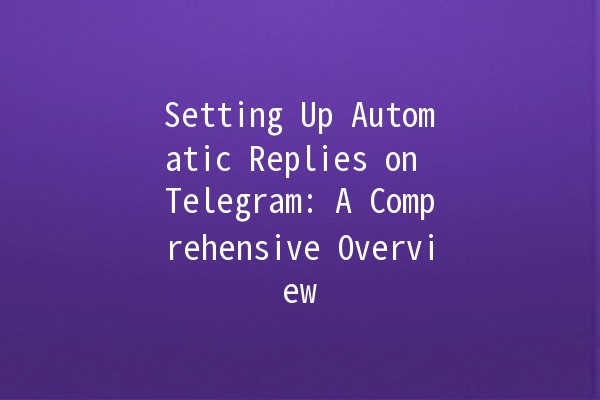Setting Up Automatic Replies on Telegram: A Comprehensive Overview

Telegram has become one of the most popular messaging platforms for both personal and professional communication. One of its most useful features is the capability to set up automatic replies. This feature is especially beneficial for businesses, content creators, and individuals who want to manage their messaging efficiency. This article delves into the setup process, benefits, and applications of automatic replies on Telegram, providing a thorough understanding of how to utilize this tool effectively.
Why Use Automatic Replies on Telegram?
Before diving into the setup procedure, it's crucial to understand the benefits of automatic replies.

Getting Started with Automatic Replies on Telegram
To set up automatic replies on Telegram, you generally need to use a bot as Telegram does not have a builtin automatic reply feature for standard accounts. Below are the steps to create and implement your own automatic reply functionality using a bot.
Step 1: Create a Telegram Bot
Step 2: Setup Your Development Environment
To program your bot and define its automatic reply functions, you need a development environment. You can use programming languages like Python, Node.js, or PHP to interact with the Telegram Bot API. For this walkthrough, we will focus on Python.
```bash
pip install pythontelegrambot
```
Step 3: Write the Bot Code
Create a new Python file (example: `auto_reply_bot.py`) and write the following code.
```python
from telegram import Update
from telegram.ext import Updater, CommandHandler, MessageHandler, Filters, CallbackContext
TOKEN = 'YOUR_API_TOKEN_HERE'
def start(update: Update, context: CallbackContext):
update.message.reply_text('Hello! I am your autoreply bot. How can I help you?')
def auto_reply(update: Update, context: CallbackContext):
user_message = update.message.text
reply_message = f'You said: {user_message}. I will get back to you shortly!'
update.message.reply_text(reply_message)
def main():
updater = Updater(TOKEN)
dispatcher = updater.dispatcher
dispatcher.add_handler(CommandHandler('start', start))
dispatcher.add_handler(MessageHandler(Filters.text & ~Filters.command, auto_reply))
updater.start_polling()
updater.idle()
if __name__ == '__main__':
main()
```
Step 4: Customize Automatic Replies
Now that you have a basic setup, you can customize your automatic replies further. For instance, you could set specific keywords to trigger different responses or schedule certain messages to be sent at a later time.
```python
def auto_reply(update: Update, context: CallbackContext):
user_message = update.message.text.lower()
if 'hello' in user_message:
reply_message = "Hello! How can I assist you today?"
elif 'hours' in user_message:
reply_message = "We're open from 9 AM to 5 PM, Monday through Friday."
else:
reply_message = f'You said: {user_message}. I will get back to you shortly!'
update.message.reply_text(reply_message)
```
```bash
pip install apscheduler
```
Add scheduling capabilities:
```python
from apscheduler.schedulers.background import BackgroundScheduler
def send_scheduled_message(context):
context.bot.send_message(chat_id=context.job.context['chat_id'], text='This is a scheduled message.')
def auto_reply(update: Update, context: CallbackContext):
chat_id = update.message.chat_id
reply_message = 'This is your immediate autoreply.'
update.message.reply_text(reply_message)
context.job_queue.run_once(send_scheduled_message, when=10, context={'chat_id': chat_id})
```
Step 5: Deploy Your Bot
Now that your bot is coded and tested locally, it's time to deploy it so that it runs continuously. You can choose various hosting solutions like Heroku, AWS, or DigitalOcean.
Best Practices for Automatic Replies on Telegram
While automatic replies can significantly enhance communication, it's essential to approach them thoughtfully. Here are some best practices:
Automatic replies on Telegram represent a powerful tool that enhances communication, increases efficiency, and fosters better customer relations. Whether for business or personal use, setting up your bot for automatic replies can seem daunting at first, but following the steps outlined in this article simplifies the process significantly.
With a basic understanding of coding and an API token, you can create a bot that meets your specific needs. As technology continues to evolve, integrating automation into communication will become increasingly vital, making the exploration and implementation of features like automatic replies more crucial than ever.
By following the best practices outlined and regularly maintaining your bot, you can ensure that it serves as an effective communication asset that strengthens your online engagements. Embrace automation, and watch how it can transform your Telegram experience, making interactions smoother and more efficient for everyone involved.
Other News

如何在TelegramX中进行群组投票 🤖📊

Telegram安装时间优化 🚀📱

Telegram Mac版下載地址及其特色功能探索!
